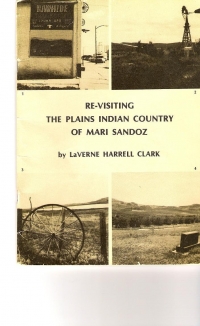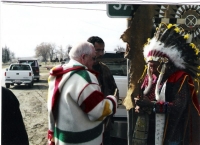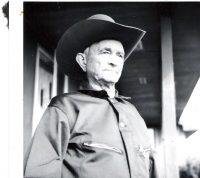REVIEWS & FEATURES ABOUT LaVERNE HARRELL CLARK'S WRITNGS ON MARI SANDOZ & HER RELATED PHOTOGRAPHS
Posted Jun 7, 2005
Last Updated Jun 21, 2012
REVIEWS OF CLARK'S MARI SANDOZ'S NATIVE NEBRASKA: THE PLAINS INDIAN COUNTRY (Arcadia Publishers, Charleston, S.C., 2000; $18.99 paperback, ISBN 0-7385-0784-9, 128 pages; 232 black and white photographs)
Part of the Review from JOURNAL STAR (Lincoln, Nebraska) (1/28/2001)
NEBRASKA BOOK SHELF COLUMN
Headline: Book on Sandoz captures life, land of autbor
by Christine Pappas
Mari Sandoz was a "major interpreter of her homeland," according to LaVeme Harrell Clark, author of "Mari Sandoz's Native Nebraska: The Plains Indian Country."
This book is short....but its 232 annotated photos of the life and literary career of Marl Sandoz make it a unique addition to any library.Published in softcover by Arcadia Press, it sells for $18.99.
The book appears at an important time in Sandoz studies because of the new Marl Sandoz High Plains Center opening on the campus of Chadron State College.
Clark's book is truly one of a kind....essentially a biography of Sandoz, a history of the Native people in her region of the Sandhills and a photo album of the scenes in Sandoz's books all rolled into one volume.
As Clark explains in her introduction, a map of Sandoz's landscape is particularly important for a deeper understanding of her words. To know the land is to know Sandoz's words. When Sandoz researched a book, she took the manuscript to its locale and read it on the scene, retracing the terrain.
In a telephone interview from her home in Smithville, Texas, Clark explained how well-qualified she is to write a book about Sandoz. Sandoz [heard about] Clark's first book, "They Sang for Horses," from mutual friends. It is about the Navajo and Apache, and was then forthcoming, though not to appear until after Sandoz's death. But Sandoz was impressed and sent Clark word through the friends that she would like to meet her.
Unfortunately, the two authors never met. Sandoz died of breast cancer in March 1966, the same year that "They Sang for Horses" was published in the fall. Clark won the University of Chicago Folklore Prize in 1967 for that book, which the University of Colorado Press is presently in the process of reissuing with her photographs.
In later years, Clark came to know Sandoz's sister Caroline Sandoz Pifer, who served as her literary executor. Pifer's intimate knowledge of the sites depicted in her sister's writing--especially in "Crazy Horse" and "Cheyenne Autumn"- provided key information for Clark's book. She introduced Clark to Natives whom Sandoz had known and showed her around Fort Robinson and the Pine Ridge Reservation.
Sandoz was born near Hay Springs in 1896. She was a "friend to the Indians," as her bust in the Nebraska Hall of Fame reads. Clark captures Sandoz's empathy with dozens of photos as well as detailed descriptions of incidents in Native history that Sandoz recounted in her books. Clark also emphasizes that Sandoz was less than fond of Buffallo Bill Cody and George Custer, and that she sought to debunk both of them in her books on the West.
Clark's expertise as an historian and photographer come together in the information she presents about the Cheyenne's Little Fingernail. First, photographs show drawings done by Little Fingernail. Pages later, after reading the story of the murder of Little Fingerail, which Sandoz tells in "Cheyenne Autumn," Clark directs the reader's attention back to the drawings, explaining that the tears shown on the reproductions of them in the book actually came about from the Springfield rifle that killed him, the tribal chronicler. (He kept the drawings that recorded his pictorial history in his shirt, over his chest.)
Without a nuanced understanding of history, as well as the ability to show detail that photos allow, the emotional but subtle effect of the bullet holes would be lost.
The book focuses on Sandoz's Nebraska experiences rather than her time in NYC. Lincolnites will enjoy the photos--both new and historical--of sights in Lincoln that Sandoz frequented, including the Nebraska Historical Society, the Capitol and the University of Nebraska. While in Lincoln, Sandoz pursued writing but Clark shows that she could also become very discouraged. One UNL professor, Mamie Meredith, witnessed Sandoz burning almost 100 of her stories that she could not get published.
Clark is also the author of "Revisiting the Plains Indian Country of Mari Sandoz," published in 1979 by Blue Cloud Abbey Press.
-----------------
Review from NEBRASKA LIFE
Nebraskans never get enough of Mari Sandoz. The daughter of the Sandhills has been dead for 35 years, but her popularity continues to grow. LaVerne Clark's book is testimony to that.
Clark is a Texan, but she knows Sandoz. She has wrilten several articles on the author. For Native Nebraska she collected more than 200 black and white photographs [most of them of her own making] of the Sandoz family and places important to them. Her captions constitute an easy-ro-read narrative of a woman who spoke only German until age nine but became one of the American West's best writers.
Readers who travel western Nebraska and southwestern South Dakota will identify with many scenes in the book. such as Fort Robinson, the Fur Traders Museum at Chadron, and views of the Pine Ridge country. Many of the photographs included by Clark picture Native American scenes.
The author includes just enough snippets of Sandoz's writings to color the pages. Under a picture of Mari's parents, she includes this passage from Old Jules: "Mary threw up her knotted hands and rolled her faded blue eyes back. Now he had gone crazy. The children drew away into the shadows, their voices buzzing softly, 'Got to live in the sandhills where gray wolves live, and the cattlemen, the rattlesnakes.'
The book can be read in a single sitting or savored for several nights. It is both Sandoz and Nebraska history.
------
Review from BLOOMSBURY REVIEW (July/Aug. 2001), p.23
by Lori D. Krans
"More than 200 black and white images
illustrate the land and people of Mari Sandoz's histories and novels: the Sand Hills of northwestern Nebraska. Divided chronologically into five chapters, from 1894 to 1970, this book is a photographic guide to Sandoz' milieu: her life, her family, the Native American cultures of the area, and her literature. The long descriptive captions make this book an essential reference on one of the Great Plains' major writers, whose most famous work is Old Jules, a biography of her father, one of the state's early, and probably best-known settlers, and a classic of American western literature. The publication of this book coincides with the opening of the Mari Sandoz High Plains Center in Chadron, Nebraska.
-------
Reviews of
the o.p. RE-VISITING THE PLAINS INDIAN
COUNTRY OF MARl SANDOZ. Published by
Blue Cloud Abbey Press,
Marvin, S.D. 57251.
Written and photographed
by LaVerne Harrell Clark
From the Blue Cloud series' advertisement:
LaVerne Clark's photos, each accompanied by explanatory text, record her visits to people and places important in Mari Sandoz' life and writing.
One tlme 1 met a high school English teacher who didn't know who Mari Sandoz was. He might have been excused because he was not a native Nebraskan, but he shouldn't have been excused because he was teaching in Nebraska. 1 asked him, "Are you acquainted with the work of Willa Cather?" Of course he was.
Here at Blue Cloud, we believe Mari Sandoz was an important writer.
Brother Benet, O.S.B., Editor of BLUE CLOUD SERIES, which included the title as #5 in its list of publications.
"Mari Sandoz wrote ten books about the Sioux and Cheyenne Indians of her native region because she wanted to understand them and her own roots. LaVerne Harrell Clark has given us a remarkable pictorial biographical study of this outstanding author. She has peformed a remarkable labor of love for all of us who long for detailed information regarding the life and times of the west and its pioneer people."-Bart Lanier Stafford III, El Paso "Book Shelf"
"Few would deny that her [Sandoz's] novels make absorbing reading...LaVerne Harrell Clark provides a brief pictorial biographical study of Sandoz. This.. .little book.. .should appeal to anyone interested in Sandoz or the Plains Indians about whom she wrote."- W.K. McNeil, JOURNAL OF AMERICAN FOLKLORE
Part of the Review from JOURNAL STAR (Lincoln, Nebraska) (1/28/2001)
NEBRASKA BOOK SHELF COLUMN
Headline: Book on Sandoz captures life, land of autbor
by Christine Pappas
Mari Sandoz was a "major interpreter of her homeland," according to LaVeme Harrell Clark, author of "Mari Sandoz's Native Nebraska: The Plains Indian Country."
This book is short....but its 232 annotated photos of the life and literary career of Marl Sandoz make it a unique addition to any library.Published in softcover by Arcadia Press, it sells for $18.99.
The book appears at an important time in Sandoz studies because of the new Marl Sandoz High Plains Center opening on the campus of Chadron State College.
Clark's book is truly one of a kind....essentially a biography of Sandoz, a history of the Native people in her region of the Sandhills and a photo album of the scenes in Sandoz's books all rolled into one volume.
As Clark explains in her introduction, a map of Sandoz's landscape is particularly important for a deeper understanding of her words. To know the land is to know Sandoz's words. When Sandoz researched a book, she took the manuscript to its locale and read it on the scene, retracing the terrain.
In a telephone interview from her home in Smithville, Texas, Clark explained how well-qualified she is to write a book about Sandoz. Sandoz [heard about] Clark's first book, "They Sang for Horses," from mutual friends. It is about the Navajo and Apache, and was then forthcoming, though not to appear until after Sandoz's death. But Sandoz was impressed and sent Clark word through the friends that she would like to meet her.
Unfortunately, the two authors never met. Sandoz died of breast cancer in March 1966, the same year that "They Sang for Horses" was published in the fall. Clark won the University of Chicago Folklore Prize in 1967 for that book, which the University of Colorado Press is presently in the process of reissuing with her photographs.
In later years, Clark came to know Sandoz's sister Caroline Sandoz Pifer, who served as her literary executor. Pifer's intimate knowledge of the sites depicted in her sister's writing--especially in "Crazy Horse" and "Cheyenne Autumn"- provided key information for Clark's book. She introduced Clark to Natives whom Sandoz had known and showed her around Fort Robinson and the Pine Ridge Reservation.
Sandoz was born near Hay Springs in 1896. She was a "friend to the Indians," as her bust in the Nebraska Hall of Fame reads. Clark captures Sandoz's empathy with dozens of photos as well as detailed descriptions of incidents in Native history that Sandoz recounted in her books. Clark also emphasizes that Sandoz was less than fond of Buffallo Bill Cody and George Custer, and that she sought to debunk both of them in her books on the West.
Clark's expertise as an historian and photographer come together in the information she presents about the Cheyenne's Little Fingernail. First, photographs show drawings done by Little Fingernail. Pages later, after reading the story of the murder of Little Fingerail, which Sandoz tells in "Cheyenne Autumn," Clark directs the reader's attention back to the drawings, explaining that the tears shown on the reproductions of them in the book actually came about from the Springfield rifle that killed him, the tribal chronicler. (He kept the drawings that recorded his pictorial history in his shirt, over his chest.)
Without a nuanced understanding of history, as well as the ability to show detail that photos allow, the emotional but subtle effect of the bullet holes would be lost.
The book focuses on Sandoz's Nebraska experiences rather than her time in NYC. Lincolnites will enjoy the photos--both new and historical--of sights in Lincoln that Sandoz frequented, including the Nebraska Historical Society, the Capitol and the University of Nebraska. While in Lincoln, Sandoz pursued writing but Clark shows that she could also become very discouraged. One UNL professor, Mamie Meredith, witnessed Sandoz burning almost 100 of her stories that she could not get published.
Clark is also the author of "Revisiting the Plains Indian Country of Mari Sandoz," published in 1979 by Blue Cloud Abbey Press.
-----------------
Review from NEBRASKA LIFE
Nebraskans never get enough of Mari Sandoz. The daughter of the Sandhills has been dead for 35 years, but her popularity continues to grow. LaVerne Clark's book is testimony to that.
Clark is a Texan, but she knows Sandoz. She has wrilten several articles on the author. For Native Nebraska she collected more than 200 black and white photographs [most of them of her own making] of the Sandoz family and places important to them. Her captions constitute an easy-ro-read narrative of a woman who spoke only German until age nine but became one of the American West's best writers.
Readers who travel western Nebraska and southwestern South Dakota will identify with many scenes in the book. such as Fort Robinson, the Fur Traders Museum at Chadron, and views of the Pine Ridge country. Many of the photographs included by Clark picture Native American scenes.
The author includes just enough snippets of Sandoz's writings to color the pages. Under a picture of Mari's parents, she includes this passage from Old Jules: "Mary threw up her knotted hands and rolled her faded blue eyes back. Now he had gone crazy. The children drew away into the shadows, their voices buzzing softly, 'Got to live in the sandhills where gray wolves live, and the cattlemen, the rattlesnakes.'
The book can be read in a single sitting or savored for several nights. It is both Sandoz and Nebraska history.
------
Review from BLOOMSBURY REVIEW (July/Aug. 2001), p.23
by Lori D. Krans
"More than 200 black and white images
illustrate the land and people of Mari Sandoz's histories and novels: the Sand Hills of northwestern Nebraska. Divided chronologically into five chapters, from 1894 to 1970, this book is a photographic guide to Sandoz' milieu: her life, her family, the Native American cultures of the area, and her literature. The long descriptive captions make this book an essential reference on one of the Great Plains' major writers, whose most famous work is Old Jules, a biography of her father, one of the state's early, and probably best-known settlers, and a classic of American western literature. The publication of this book coincides with the opening of the Mari Sandoz High Plains Center in Chadron, Nebraska.
-------
Reviews of
the o.p. RE-VISITING THE PLAINS INDIAN
COUNTRY OF MARl SANDOZ. Published by
Blue Cloud Abbey Press,
Marvin, S.D. 57251.
Written and photographed
by LaVerne Harrell Clark
From the Blue Cloud series' advertisement:
LaVerne Clark's photos, each accompanied by explanatory text, record her visits to people and places important in Mari Sandoz' life and writing.
One tlme 1 met a high school English teacher who didn't know who Mari Sandoz was. He might have been excused because he was not a native Nebraskan, but he shouldn't have been excused because he was teaching in Nebraska. 1 asked him, "Are you acquainted with the work of Willa Cather?" Of course he was.
Here at Blue Cloud, we believe Mari Sandoz was an important writer.
Brother Benet, O.S.B., Editor of BLUE CLOUD SERIES, which included the title as #5 in its list of publications.
"Mari Sandoz wrote ten books about the Sioux and Cheyenne Indians of her native region because she wanted to understand them and her own roots. LaVerne Harrell Clark has given us a remarkable pictorial biographical study of this outstanding author. She has peformed a remarkable labor of love for all of us who long for detailed information regarding the life and times of the west and its pioneer people."-Bart Lanier Stafford III, El Paso "Book Shelf"
"Few would deny that her [Sandoz's] novels make absorbing reading...LaVerne Harrell Clark provides a brief pictorial biographical study of Sandoz. This.. .little book.. .should appeal to anyone interested in Sandoz or the Plains Indians about whom she wrote."- W.K. McNeil, JOURNAL OF AMERICAN FOLKLORE



